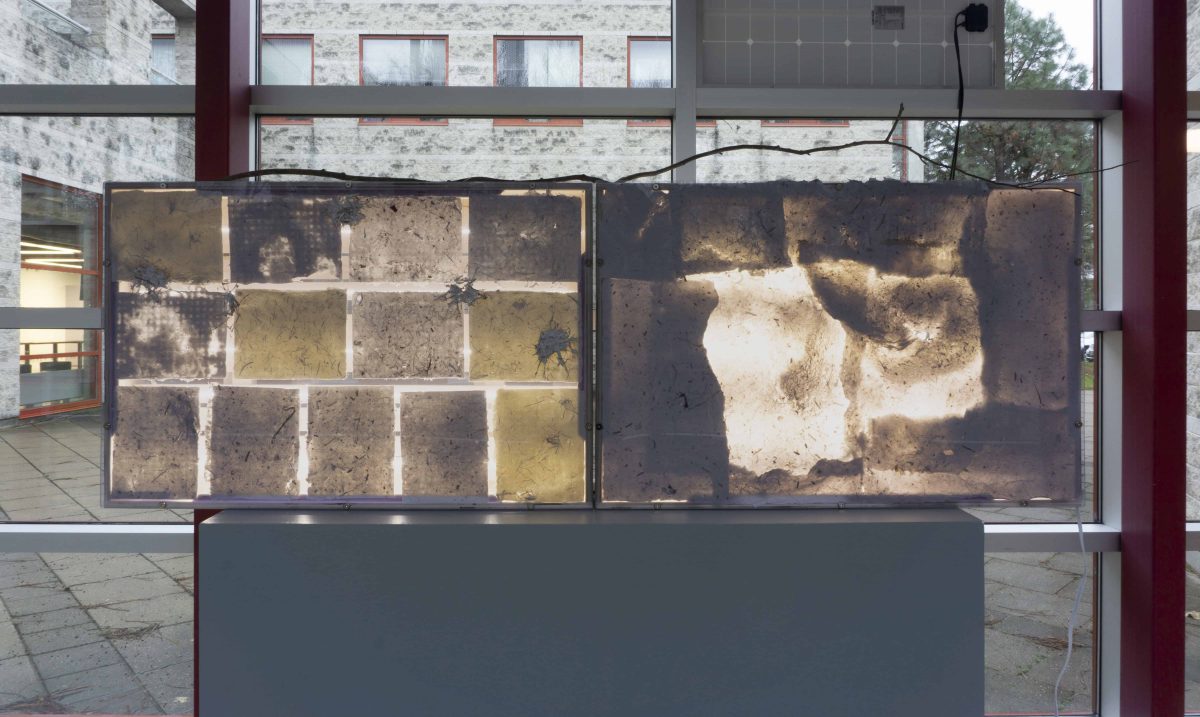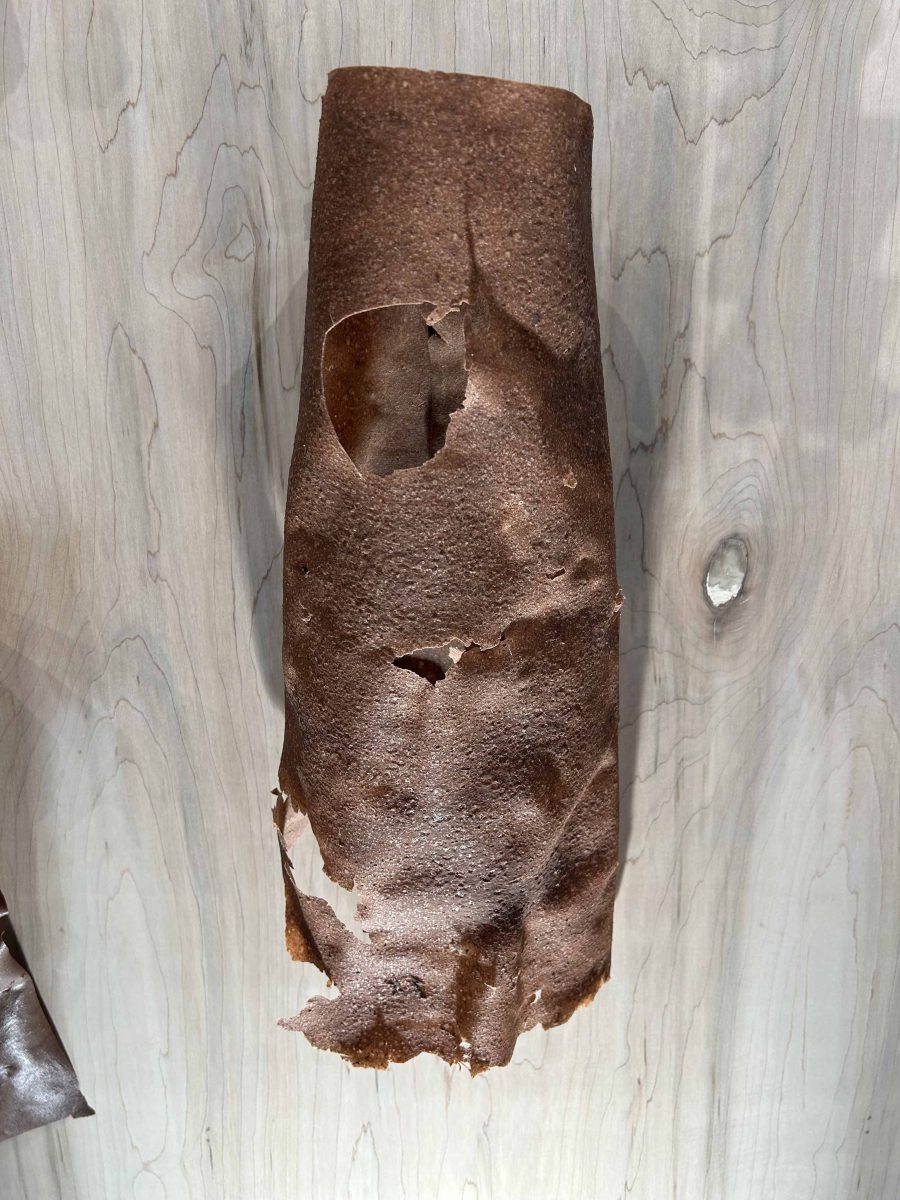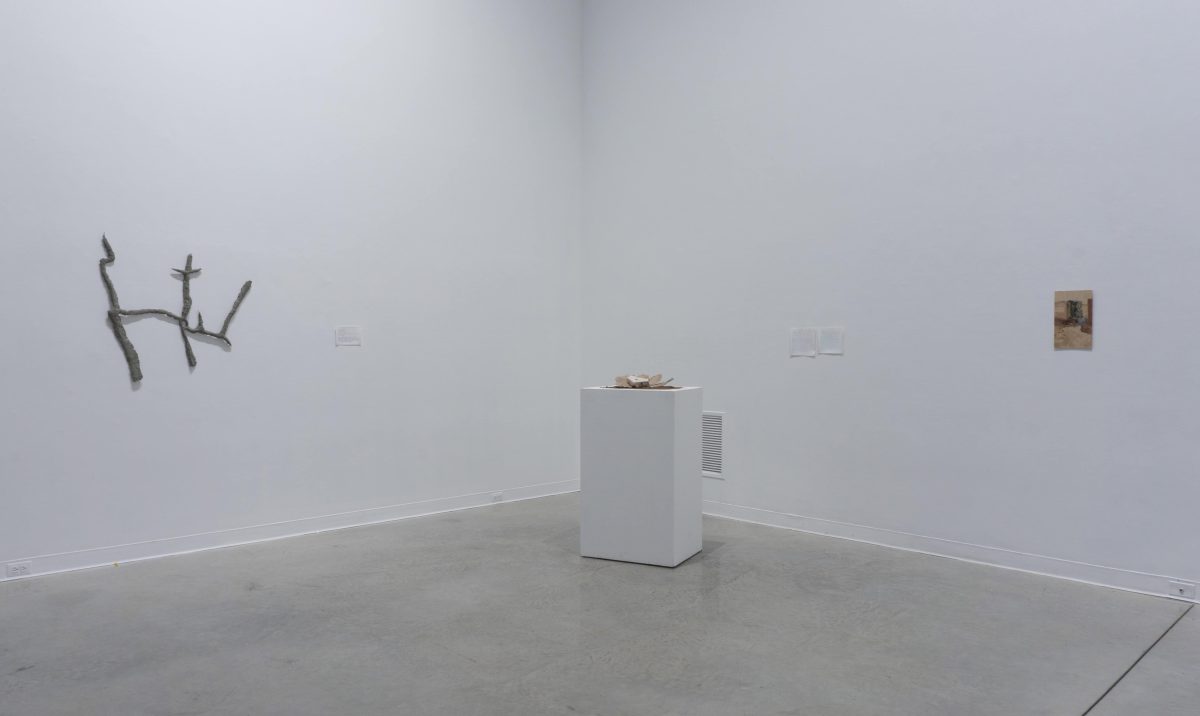Many collaborators actively contribute to the CSC, and we’d like to introduce you to some of their work. Meet Danielle Petti & Jessica Irene Joyce.
Danielle and Jessica’s practices prioritize deep-rooted concerns for sustainability and climate change. Both have been active members in the Department of Visual Arts at Western University: Danielle recently completed an MFA (2025), and Jessica is working toward a PhD. Danielle and Jessica are active and ongoing contributors to the CSC.

Can you tell us about your work with Neptune balls, how you came to collaborate together, and your subsequent project for the SustainableCities: A Collective Eclipsing exhibition.
Danielle: I really like Imogen Clendinning’s term for the Neptune balls: subaqueous tumbleweed! They are naturally occurring bundles of beach grass that get tangled with each other, collecting detritus and also microplastics. We had both been part of conversations with Professor Sheri Osden Nault about material agency, and those ideas shaped how we approached the project. We began experimenting with the Neptune fibres in Jessica’s studio and quickly noticed how closely they resembled the dynamics of pulp fibres in paper: tangled and shaped by movement. The process of forming sheets echoed the motion of the water they came from. The Neptune balls already seemed to be performing a kind of environmental work, filtering and catching material as they moved through the water. The idea of honouring that work through a transformation into paper felt like a really thoughtful continuation.
Working together for SustainableCities: A Collective Eclipsing allowed us to develop these ideas further and share them in a public way. Thanks to Imogen Clendinning’s curatorial work, we were able to display the final papers in solar-powered lightboxes, which backlit the fibres. It felt like a fitting way to make the material visible again, not just physically, but in terms of the stories and labour they carry.
Jessica: When Dr. Robertson mentioned that the Neptune balls were starting to disintegrate and that she was interested in finding ways to extend their lifetimes, my first thought was to try grinding one up to see if I could use it as an oil paint pigment. Naturally, I thought to connect with Danielle because working with found pigments is one of her specialties. We came to the method of papermaking by having a conversation about the material properties of the Neptune balls. Although my first instinct was to find a way to paint with them since that is my main artistic mode, Danielle mentioned that the natural fibres probably would not make very chromatic pigments. We were also concerned about the pigment-making process, which would require boiling the Neptune balls. They possess chemical properties unknown to us, and we did not necessarily want to inhale fumes from the boiling water. Then there would be the problem of disposing of the potentially contaminated water afterward. We came to papermaking because the process by which the Neptune balls create themselves is similar to the process of papermaking. Fibres entangle with one another and hold together. Paper fibres are smaller and more uniform than Neptune ball fibres, so their tangles tend to be more durable. Danielle has expertise in papermaking, so she agreed to teach me her methods as part of our collaboration. I was very committed to continuing what I saw as the ‘mission’ of the Neptune balls, to capture and remove microplastics from the beach and water. In the forms they took for our collaborative artwork, Gathering Tendencies, they are paper art objects that will probably deteriorate over a longer timescale than they would have in their previous forms because the paper pulp holds their materials together closely and tightly.
I’d love to know more about your collaborative materials research. Can you share a bit about what this process looked like? What you discovered, and how this kind of work informs both your collaborative and your individual practices.
J: Since I have known Danielle, I have referred to her as a ‘mad scientist’ because of how she engages with her materials with fearless creativity. Every time we work together, it feels like re-experiencing the childhood delight of mixing ‘potions’ in the backyard. For Gathering Tendencies, we set up a kiddie pool in my studio so that we could make sheets of paper as large as we wanted. We took turns blending up shredded recycled paper to make the paper pulp and mixed it in the pool with the Neptune balls. Some of the balls were left whole and we untangled others by hand so that they could integrate into the paper pulp. We even attempted to capture our process on a waterproof GoPro camera, but the paper pulp made the water too cloudy to be able to capture much detail. It was a joyful afternoon of creative experimentation that generated an exciting artwork. I love working on projects with Danielle because my main studio practice can be quite solitary. I spend a lot of time painting outside, and although I am usually surrounded by plants, trees, and animal friends, it is a delightful change of pace to collaborate with another human artist with similar conceptual concerns.
D: Jess is such a great communicator, both in painting and in conversation. Working with her on these projects is grounding, which is why I hope we can collaborate more in the future. I tend to get mentally tangled in the mess of my materials, so I think we balance each other out in a really good way. Jess’s initial kinship with the Neptune balls and her determination to become their ally (to carry their story forward) was so poetic. I’m really glad we were able to do that together.

Can you speak a bit about the sculptures you made for the Test Site exhibition?
J: After our work with the Neptune balls and the SustainableCities exhibition, Dr. Robertson commissioned the sculptures we made for Test Site and provided access to the Sustainable Materials Recipe Database compiled by the Synthetic Collective. Danielle and I each read through the recipes, mostly focusing on the bioleathers and biotextiles. The first recipe we tested was a clay leather because clay is a material that Danielle frequently works with, and we thought it would be interesting to see how her found red clay would incorporate into the recipe (or not). The other recipe we tested was for a coffee bioleather. We selected it because Dr. Robertson had an existing collection of used coffee grounds and we were curious about some of the other ingredients–like sodium alginate. I was a chef before I began grad school, so anything food-related is always attractive to me, and alginate is derived from seaweed. The idea of making a durable material that can be used to construct something like a purse out of mostly edible ingredients was too tantalizing to resist.
Both leathers behaved differently, and we encountered several surprises during the process. The coffee leather had a tiny hole that was made when it was pulled off the screen, and I used that as an opportunity to test visible mending on it. The stitching looks the same as the day I did it, almost a year ago now, and the coffee bioleather has completely retained its flexibility. The clay leather has become slightly more brittle than it was when it was produced, but it remains pliable.

How has collaborating together and along with the CSC informed your individual practices?
J: Working with Dr. Robertson, Danielle, and the CSC has broadened my awareness of choice when it comes to artmaking materials and processes. My culinary background already had the effect of creating in me a sensitivity to the material properties of the pigments I work with in my painting practice, and I came into grad school wanting to engage with ecological anxiety and activism; being surrounded by like-minded creative people while I pursue my own artistic goals provides a sense of support and constant innovation that is very exciting.
The CSC has had a significant impact on the curatorial techniques that are employed within our department and beyond. The use of vinyl wall text is becoming increasingly rare, and the artists in our department experiment with a wide variety of materials to replace it. The result is that the didactics become a considered artistic feature of our exhibitions. For my MFA thesis exhibition in the artLAB gallery at Western, I hand-painted the title wall in my handwriting, and it added an irreplaceable personal touch that felt very special to me. I also wanted a complementary accent colour painted onto the wall leading into my exhibition. Since I do not purchase new art materials for my projects unless absolutely necessary, I asked the gallery director, Liza Eurich, if I could go through the gallery’s collection of leftover paint from previous exhibitions. To my delight, I found a vibrant shade of orange that was an almost perfect match to one of the signature colours featured in multiple paintings in the exhibition. I think that artists sometimes believe that incorporating sustainable considerations into their practices means sacrificing a percentage of their artistic freedom, but I have found that the limitations I place on my material consumption are now some of the most powerful drivers of my creativity.
D: The CSC challenges the idea that artwork needs to be made with conventional, long-lasting materials to be considered valuable or archival. That shift has opened up a lot for me. It’s made me more comfortable working with materials that are ephemeral, biodegradable, or delicate. Sustainability isn’t always the central theme of my work, but it’s a condition of how I work. The research I’ve undertaken alongside Sheri Osden Nault and Dr. Kirsty Robertson has deepened that approach. Being part of a community of artists and academics who are exploring sustainable and unconventional methods has been energizing. It’s helped me see my practice as part of a larger conversation between people, materials, and the places we live in.
Danielle Petti’s work weaves together themes of material agency, geological time, sustainability, and care. Her practice challenges anthropocentric views, positioning herself as a participant in broader ecological and temporal processes. Drawing on natural phenomena, her art bridges scientific, domestic, and environmental narratives, creating works that are simultaneously intimate and expansive. Her practice offers a reflective and critical engagement with the materials and stories of the rocks. Danielle has a BFA from Toronto Metropolitan University (2012) and is currently finishing her MFA degree at Western University (2025). She is cross-disciplinary, drawing from experience in photography, painting, printmaking, several crafts, and folk arts. She has received awards from Canada Council for the Arts, Region of Waterloo Arts Fund, and London Arts Council. Danielle aims to create responsibly by resourcefully sourcing material from the recycling bin and by foraging for bits of earth both globally and locally, on the traditional territories of the Anishinaabek, Haudenosaunee, Lūnaapéewak, and Neutral peoples.
Jessica Irene Joyce (she/her) is an artist in a long-term relationship with painting. She paints to document relationships to self, materials, and ecologies, and how these are transformed by reading about and living through the impacts of climate change. Jessica holds a BFA in Studio Arts with a specialization in painting from Concordia University (2015) and an MFA in Visual Arts from Western University (2024). She is currently pursuing a PhD in Art and Visual Culture and is a contributing editor for Embassy Cultural House. Her paintings have been exhibited in Montreal, St. John’s, and throughout Southwestern Ontario.